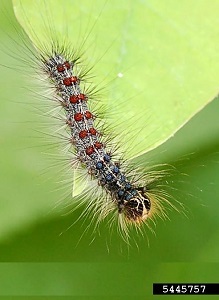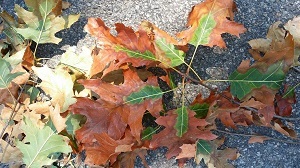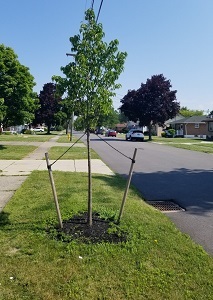Check in on your trees this summer
The New York State Department of Environmental Conservation sent this bulletin on 07/22/2020 05:33 PM EDT |
| DEC Delivers - Information to keep you connected and informed from the NYS Department of Environmental Conservation |
| Share or view as a web page || Update preferences or unsubscribe |
Forests, Plants, and Land Conservation News |
|
This Month's Topics:
Gypsy Moth Caterpillar Damage Common Across the State
The caterpillars are beginning to disappear now as they pupate and become moths. One year of defoliation is not likely to kill your trees, but 2-3 years of defoliation typically leads to some tree death. DEC will be monitoring populations to predict whether another major defoliation could be expected next year or not. For more information on gypsy moths in New York State, visit our website. Photo: Gypsy moth caterpillars were a common sight on deciduous trees across the state this summer. At this time of the season, the caterpillars are beginning to turn into moths. (Photo by Bugwood.org) Check in With Your TreesIf you have trees on your street or in your yard, this is your friendly reminder to do a seasonal check-in. Take a look at your trees and ask yourself the following questions:
If you have concerns, you may want to contact a certified arborist or tree service. Checking in with your trees periodically and noticing any unusual changes is the first step in making sure they can continue to help our Earth for years to come. What You May See NowTar Spot
The fungus can overwinter in leaf litter in your yard. If you would like to prevent tar spot in your trees for next year, be sure to remove all leaf litter when the leaves fall in autumn. Photo: Maple leaves with signs of tar spot. Oak Wilt
DEC tracks and manages oak wilt disease in New York State. If you see these signs on an oak this July or August, you may contact DEC's Forest Health team for confirmation. Photo: Leaves from a red oak tree infected with oak wilt. Infected red oak trees lose all or most of their leaves very quickly in July or August. Get to Know New York's Natives: Cow ParsnipCaution: This native plant can cause burns on skin If you follow DEC on any social media platforms, it’s hard to miss that giant hogweed season is upon us. Giant hogweed is a large invasive plant from Eurasia that contains sap which can cause burning on your skin. Giant hogweed is found in many parts of the state (particularly Western and Central NY), but there are many look-alike species that can often get misidentified as this plant.
Cow parsnip is relatively uncommon in New York, but it prefers to grow in cooler habitats with moist soils or near water. Like invasive giant hogweed, our native cow parsnip also contains sap that can cause a blistering, itchy rash on skin, though the sap is not considered to be as toxic as giant hogweed. If you come in contact with the sap of this plant, immediately wash the area with soap and water and protect it from sunlight for 48 hours. You can read more about native cow parsnip on our website. If you believe you have spotted the purple-splotched stem of an invasive giant hogweed plant this summer, please report it to DEC. Photo: Our native cow parsnip blooms earlier in the season and tends to be shorter in height than invasive giant hogweed. Cow parsnip has a plain green stem with fine white hairs. August 1 Deadline for Hudson River Estuary Trees for Tribs ProgramThe Hudson River Estuary Program's Trees for Tribs offers free native trees and shrubs for planting along tributary streams in the Hudson River estuary watershed. If you own or manage property near a stream in the Hudson estuary watershed, you may qualify. The program is now accepting applications for fall plantings and the application deadline is August 1. Staff are able to help applicants with a planting plan. Since 2007, Trees for Tribs has provided more than 40,000 native trees and shrubs for planting along 20 miles of stream with the help of more than 9,000 local volunteers. For more information about the program or to download an application, visit DEC's website. Play Smart * Play Safe * Play Local
PLAY SMART * PLAY SAFE - Practice social distancing, wash your hands, wear a mask to protect yourself and others. If your destination is crowded, find somewhere else to go. PLAY LOCAL - Stay close to home and #RecreateLocal in your region. PLAY SMART - Plan ahead. Make a list of alternative destinations and places to visit. PLAY SAFE - Stay home if you're sick or if you're part of a vulnerable population. Urban and Community Forestry (UCF) CornerReLeaf ConferenceIn light of the ongoing COVID-19 pandemic, the ReLeaf Conference that was originally scheduled for July of this year has been postponed until next summer. We will remain in Buffalo for next year's conference from July 22-24, 2021 - so mark your calendars now! Community Highlight
Grants from DEC's Urban Forestry Program and the NYS Urban Forestry Council have played an important role in the town’s progress. Cheektowaga is currently in the process of adding 231 trees to the 16,302 street trees and 786 park trees they already have. These new trees will fill gaps in their street tree population and help beautify and invigorate the landscape of their town park. Central to the improvement of their town park was a concentration of plantings dedicated as part of their local Arbor Day celebration. Past projects have also included a full inventory of their public trees and a comprehensive management that was plan drawn up to keep their goals in order and their progress on track. The Town has every tree organized by size class uploaded into an interactive map on their public website. Cheektowaga's work to date is certainly no small task, but it is such dedication to growing and maintaining a dynamic and enduring urban forest that makes all the difference in our finest communities across New York State. What We're Watching
#GetCountedNY
New York urges you to be part of our complete count effort, which will ensure census data is accurate. It’s quick and simple to participate, and it can even be done online now. Don’t be anonymous. Make sure you are counted in the 2020 U.S. Census and encourage friends, family, and co-workers to participate as well. Census data is an important tool that will help shape our future, and an accurate tally will help ensure everyone counts when it comes to key decisions impacting our future. |

 If you've noticed it's a boom year for gypsy moth caterpillar activity, you're not alone. This summer, DEC has been receiving reports of higher-than-usual gypsy moth populations and leaf damage in several parts of New York State. Gypsy moths are non-native, but naturalized, meaning they will always be around in our forests. They tend to spike in numbers roughly every 10-15 years, but these outbreaks are usually end by natural causes such as predators and disease.
If you've noticed it's a boom year for gypsy moth caterpillar activity, you're not alone. This summer, DEC has been receiving reports of higher-than-usual gypsy moth populations and leaf damage in several parts of New York State. Gypsy moths are non-native, but naturalized, meaning they will always be around in our forests. They tend to spike in numbers roughly every 10-15 years, but these outbreaks are usually end by natural causes such as predators and disease. Noticing black spots on your maple leaves this summer? Your maple tree may have tar spot - but fear not!
Noticing black spots on your maple leaves this summer? Your maple tree may have tar spot - but fear not!  In July and August, keep a look out for signs of
In July and August, keep a look out for signs of  In New York State, our closest native look-alike species is cow parsnip (Heracleum maximum). Cow parsnip can grow to be more than six feet tall and has white, umbel-shaped flowers. The easiest way to distinguish cow parsnip from giant hogweed is by looking at the stem. While the invasive giant hogweed has purple splotches and coarse white hairs on its stem, the stem of the cow parsnip plant is plain green with fine white hairs. Cow parsnip’s flowers attract birds, butterflies, and ladybugs, but at this time of year, the plant has typically just finished or is wrapping up its blooming stage.
In New York State, our closest native look-alike species is cow parsnip (Heracleum maximum). Cow parsnip can grow to be more than six feet tall and has white, umbel-shaped flowers. The easiest way to distinguish cow parsnip from giant hogweed is by looking at the stem. While the invasive giant hogweed has purple splotches and coarse white hairs on its stem, the stem of the cow parsnip plant is plain green with fine white hairs. Cow parsnip’s flowers attract birds, butterflies, and ladybugs, but at this time of year, the plant has typically just finished or is wrapping up its blooming stage. Summer's here and it's time to get outside safely and responsibly. During the COVID-19 public health crisis,
Summer's here and it's time to get outside safely and responsibly. During the COVID-19 public health crisis,  This month we highlight work done in Cheektowaga, Buffalo's second largest suburb. The Town of Cheektowaga is one of several communities in Western NY that is proactively managing their public trees to make their communities a more vibrant place to live and work. But the size of Cheektowaga – 30 square miles – makes this a large challenge.
This month we highlight work done in Cheektowaga, Buffalo's second largest suburb. The Town of Cheektowaga is one of several communities in Western NY that is proactively managing their public trees to make their communities a more vibrant place to live and work. But the size of Cheektowaga – 30 square miles – makes this a large challenge. Did you complete the census yet?
Did you complete the census yet?